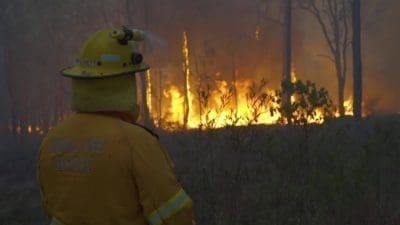
NEW research has found the 2019-20 black summer bushfires were driven by a complex interaction between the fire and the atmosphere.
Led by the Bureau of Meteorology and the Bushfire and Natural Hazards CRC, a group of scientists used computer simulations to examine fires in the Badja Forest (New South Wales), Green Valley Talmalmo/Corryong (NSW/Victoria), Kangaroo Island (South Australia), Stanthorpe (Queensland) and Yanchep (Western Australia).
BOM researcher Dr Mika Peace said the group used two linked models to analyse the fire – one simulating weather and the other simulating the fire.
“As we learn and share these findings, we are able to apply our knowledge to future bushfires,” Dr Peace said.
“Right now, we can use the findings to help fire behaviour analysts and fire meteorologists recognise the conditions that lead to extremely dangerous localised bushfire behaviour.”
Dr Peace said drought and heatwave conditions experienced in the lead up to and during all five fires were a key factor in priming the landscape for extreme fire behaviour.
But she said local weather conditions were also important when combined with the very dry vegetation.
“For the bushfires that occurred close to the coast – Yanchep in Western Australia and on Kangaroo Island – the combination of heatwave conditions, the temperature difference between the hot land and the cooler water and local topography led to complex winds that changed the bushfire behaviour,” she said.
“The modelling shows that very strong low-level winds descending to the ground behind the fire plume were a critical reason why the Badja Forest and Corryong bushfires burnt so fast overnight.”
The report found Pyrocumulonimbus (pyroCb) clouds or fire generated thunderstorms were a feature of the 2019-20 fire season and the number of pyroCb clouds recorded was an Australian record for one season.
However, the five fires examined were not all associated with pyroCb’s, highlighting that it is not the sole weather phenomenon associated with extreme fire behaviour.
This research was part of the Bushfire and Natural Hazards CRC’s Black Summer research program, funded by the Australian Government and the CRC to investigate key issues from the 2019-20 bushfire season. The research team consisted of Dr Mika Peace, Barry Hanstrum, Dr Jesse Greenslade, Dr Dragana Zovko-Rajak, Dr Abhik Santra, Dr Jeffrey Kepert, Dr Paul Fox-Hughes, Dr Harvey Ye, Tasfia Shermin and Jeffrey Jones from the Bureau of Meteorology.
Source: Bureau of Meteorology



So one farmer clears fire breaks around his property and across a peninsula that houses a town…. and they aren’t burn out while other land, some unmanaged for decades, is razed. If memory serves me well, my chem teacher taught that the ethanol family are volatile. It’s well documented that forests and forest litter create copious amounts of methane. Certain of those forests grow species that naturally produce high oil lodes. Now it sounds like we just need an ignition source to create a catastrophe. BOM can’t get the weather right days or even hours into the future; in that context, do we believe the contents of this report or is it just another lefty loon hypothesis. Models and two simulations…. big whoop! Where’s mention of the fuel? You can’t have fire without fuel. It’s a little too simple for some but it’s also the reality. If anyone else has an idea that fire can burn without fuel, I’d certainly be interested to see it for myself.